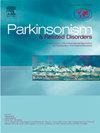Insight into the application of optogenetics for regulating motor-related circuits in Parkinson's disease and novel therapeutic target exploration
IF 3.4
3区 医学
Q2 CLINICAL NEUROLOGY
引用次数: 0
Abstract
Parkinson's disease (PD) is one of the most pervasive neurodegenerative diseases. However, the etiology and pathogenesis of PD have not been fully elucidated, the underlying neural circuits or neuron types have not been fully identified, and the roles that different neuronal subtypes in distinct deep brain nuclei play in the pathophysiological process of PD need to be explored. Optogenetics is a technique that can realize the exact temporal and spatial specific control of a defined neuron subpopulation, which may contribute to the comprehension of pathophysiological mechanism of PD. For this scoping review, we screened the PubMed database. We identified articles reporting researches explored the ways to ameliorate PD symptoms and its potential mechanism using optogenetic technology. This article reviews the application of optogenetic technology in the exploration of the pathogenesis of PD. The disequilibrium of neural activity within cortico-basal ganglia-thalamo-cortical (CBT) neural circuit circuits is closely related to the generation of PD. Moreover, these insights hold the potential to greatly improve the effectiveness of DBS and advance PD treatment to new levels. Optogenetics provides a specific cell type-targeted method for neuronal manipulation that is highly accurate for clarifying the pathogenesis of PD, developing related drug targets and exploring surgical treatment mechanisms, and providing a basis for neuromodulation target development. As an alternative type of gene therapy, optogenetics might also find future use in PD therapy, and novel genome-editing technology could also potentially be applied as individualized gene therapy for genetic types of PD.
光遗传学在帕金森病运动相关电路调控中的应用及新的治疗靶点探索。
帕金森病(PD)是最普遍的神经退行性疾病之一。然而,PD的病因和发病机制尚未完全阐明,潜在的神经回路或神经元类型尚未完全确定,不同脑深部核的不同神经元亚型在PD的病理生理过程中所起的作用有待探索。光遗传学是一种能够实现特定神经元亚群的精确时空特异性控制的技术,可能有助于理解帕金森病的病理生理机制。对于这个范围审查,我们筛选了PubMed数据库。我们对利用光基因技术改善PD症状的方法及其潜在机制进行了综述。本文综述了光遗传学技术在PD发病机制研究中的应用。皮质-基底神经节-丘脑-皮质(CBT)神经回路内神经活动的不平衡与帕金森病的发生密切相关。此外,这些见解有可能大大提高DBS的有效性,并将PD治疗推向新的水平。光遗传学为阐明PD发病机制、开发相关药物靶点、探索手术治疗机制提供了一种特异性细胞类型靶向的神经元操作方法,具有较高的准确性,为神经调节靶点的开发提供了依据。作为一种替代类型的基因治疗,光遗传学也可能在PD治疗中找到未来的应用,新的基因组编辑技术也可能应用于遗传类型PD的个性化基因治疗。
本文章由计算机程序翻译,如有差异,请以英文原文为准。
求助全文
约1分钟内获得全文
求助全文
来源期刊

Parkinsonism & related disorders
医学-临床神经学
CiteScore
6.20
自引率
4.90%
发文量
292
审稿时长
39 days
期刊介绍:
Parkinsonism & Related Disorders publishes the results of basic and clinical research contributing to the understanding, diagnosis and treatment of all neurodegenerative syndromes in which Parkinsonism, Essential Tremor or related movement disorders may be a feature. Regular features will include: Review Articles, Point of View articles, Full-length Articles, Short Communications, Case Reports and Letter to the Editor.
 求助内容:
求助内容: 应助结果提醒方式:
应助结果提醒方式:


